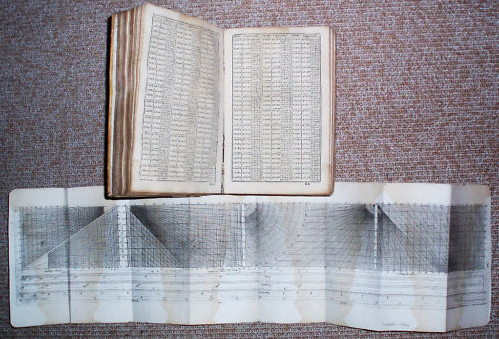In 1614 John Napier1 published the first set of logarithms. They were calculated as an exponential function which although able to be expressed as a function of modern logarithms was neither to a particular base in the modern sense, nor the natural logarithms (to base e) which “Naperian Logarithms” has come to indicate.2 Nevertheless, with them it was possible to transform the operations of multiplication and division into operations of addition and subtraction.
In the same year as Napier published his book, Henry Briggs read it noting “I never saw a book which pleased me better or made me more wonder” and three years later (following closely on the death of Napier), in 1617 published a short initial book Logarithmorum Chilias Prima on decimal logarithms (the idea of which he credited to Napier). The tables ran from 1 to 1000 with an accuracy of 14 decimal places .3
A decade later Briggs published his own Arithmetic Logarithmétique 1624, now presenting the logarithms from 1 to 20,000 and again accurate to 14 decimimal places.) In 1625 Wingate published a French edition of Brigg’s latest tables.
One year later, in 1626, Henrion published the first edition of his book of logarithmic tables, a copy of which is in this collection. Together with Wingate’s book these constituted the first logarithm tables to be published in Europe. Dennis (Didier) Henrion (~1580–1632) was a French mathematician and engineer, who in 1607, was in the service of William of Orange. He was a prolific author, his best known work being his mathematical memoirs of 1612, his translation of Euclid’s Elements over 1614–15 and his book on logarithms.
Meanwhile, in 1620, a colleague of Briggs, Professor Edmund Gunter, published his Canon triangulorum which contained logarithmic sines and tangents for every minute of arc in the quadrant to seven decimal places. In 1624 Gunter published a collection of his mathematical works entitled “The description and use of sector, the cross-staffe, and other instruments for such as are studious of mathematical practise” containing amongst other things the detail of “Gunter’s scale” (or “Gunter’s rule”) which was a logarithmically divided scale able to be used for multiplication and division by measuring off lengths and was thus the predecessor to the slide rule.4
Henrion’s book, published in 1626, brings together these various important developments in England for a European readership. In it he presents his tables of logarithms, based on those published by Briggs in 1624 together with the logarithmic sines and tangents tables from Gunter’s Canon of 1620.
In a second section (at the bottom of the photograph above), the book details the design of a logarithmic proportional rule (derived from Gunter’s 1624 publication), along with additional explanations, charts and other elaborations. The proportional rule could be used directly by means of a pair of compasses to measure off lengths corresponding to logarithms and thus to evaluate multiplications and divisions.
The volume is rare, the only one of his works which the author distributed in the Isle du Palais where he lived. The irregular pagination suggests that these two sections are intended to appear after his earlier publication in the same year of another book called “the beautiful and useful operations that are performed on the proportional compass.” The second section which is the basis of the Gunter rule is titled the ‘Logocanon or Rule Proportional: on which are applied several lines and figures, divided in various amounts and measures, for those who revel in the practicality of divine Mathematics” It has many geometrical diagrams engraved in wood.
1 http://en.wikipedia.org/wiki/John_Napier and references cited therein (↑)
2 see http://en.wikipedia.org/wiki/Napierian_logarithm (↑)
3 http://www.gap-system.org/~history/Biographies/Briggs.html (↑)
4 http://en.wikipedia.org/wiki/Edmund_Gunter - see also http://www.livres-rares.com/livres/HENRION_Denis-_Traicte_des_Logarithmes-95656.asp (↑)
Pages linked to this page
 This work by Jim Falk is licensed under a Creative Commons Attribution-NonCommercial-NoDerivs 3.0 Unported License Click on the logo to the left to see the terms on which you can use it.
This work by Jim Falk is licensed under a Creative Commons Attribution-NonCommercial-NoDerivs 3.0 Unported License Click on the logo to the left to see the terms on which you can use it.
